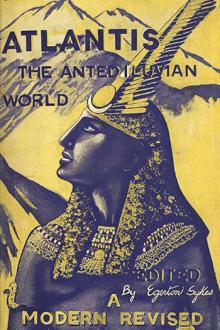Atlantis: The Antedeluvian World by Ignatius Donnelly (thriller novels to read .TXT) 📕

- Author: Ignatius Donnelly
- Performer: -
Book online «Atlantis: The Antedeluvian World by Ignatius Donnelly (thriller novels to read .TXT) 📕». Author Ignatius Donnelly
351.)
The Indian prays to the spirits of his forefathers; the Chinese religion is largely “ancestor-worship;” and the rites paid to the dead ancestors, or lares, held the Roman family together.” (“Anthropology,” p. 351.) We find the Indian practice of burying the dead in a sitting posture in use among the Nasamonians, tribe of Libyans. Herodotus, speaking of the wandering tribes of Northern Africa, says, “They bury their dead according to the fashion of the Greeks. . . . They bury them sitting, and are right careful, when the sick man is at the point of giving up the ghost, to make him sit, and not let him die lying down.”
The dead bodies of the caciques of Bogota were protected from desecration by diverting the course of a river and making the grave in its bed, and then letting the stream return to its natural course.
Alaric, the leader of the Goths, was secretly buried in the same way.
(Dorman, “Prim. Superst.,” p. 195.)
Among the American tribes no man is permitted to marry a wife of the same clan-name or totem as himself. In India a Brahman is not allowed to marry a wife whose clan-name (her “cow-stall,” as they say) is the same as his own; nor may a Chinaman take a wife of his own surname.
(“Anthropology,” p. 403.) “Throughout India the hill-tribes are divided into septs or clans, and a man may not marry a woman belonging to his own clan. The Calmucks of Tartary are divided into hordes, and a man may not marry a girl of his own horde. The same custom prevails among the Circassians and the Samoyeds of Siberia. The Ostyaks and Yakuts regard it as a crime to marry a woman of the same family, or even of the same name.” (Sir John Lubbock, “Smith. Rep.,” p. 347, 1869.) Sutteeism—the burning of the widow upon the funeral-pile of the husband—was extensively practised in America (West’s “Journal,” p.
141); as was also the practice of sacrificing warriors, servants, and animals at the funeral of a great chief (Dorman, pp. 210-211.) Beautiful girls were sacrificed to appease the anger of the gods, as among the Mediterranean races. (Bancroft, vol. iii., p. 471.) Fathers offered up their children for a like purpose, as among the Carthaginians.
The poisoned arrows of America had their representatives in Europe.
Odysseus went to Ephyra for the man-slaying drug with which to smear his bronze-tipped arrows. (Tylor’s “Anthropology,” p. 237.) “The bark canoe of America was not unknown in Asia and Africa” (Ibid., p. 254), while the skin canoes of our Indians and the Esquimaux were found on the shores of the Thames and the Euphrates. In Peru and on the Euphrates commerce was carried on upon rafts supported by inflated skins. They are still used on the Tigris.
The Indian boils his meat by dropping red-hot stones into a water-vessel made of hide; and Linnæus found the Both land people brewing beer in this way—“and to this day the rude Carinthian boor drinks such stone-beer, as it is called.” (Ibid., p. 266.) In the buffalo dance of the Mandan Indians the dancers covered their heads with a mask made of the head and horns of the buffalo. To-day in the temples of India, or among the lamas of Thibet, the priests dance the demons out, or the new year in, arrayed in animal masks (Ibid., p.
297 ); and the “mummers” at Yule-tide, in England, are a survival of the same custom. (Ibid., p. 298.) The North American dog and bear dances, wherein the dancers acted the part of those animals, had their prototype in the Greek dances at the festivals of Dionysia. (Ibid., p. 298.) Tattooing was practised in both continents. Among the Indians it was fetichistic in its origin; “every Indian had the image of an animal tattooed on his breast or arm, to charm away evil spirits.” (Dorman, “Prim. Superst.,” p. 156.) The sailors of Europe and America preserve to this day a custom which was once universal among the ancient races.
Banners, flags, and armorial bearings are supposed to be survivals of the old totemic tattooing. The Arab woman still tattoos her face, arms, and ankles. The war-paint of the American savage reappeared in the woad with which the ancient Briton stained his body; and Tylor suggests that the painted stripes on the circus clown are a survival of a custom once universal. (Tylor’s “Anthropology,” p. 327.) In America, as in the Old World, the temples of worship were built over the dead., (Dorman, “Prim. Superst.,” p. 178.) Says Prudentius, the Roman bard, “there were as many temples of gods as sepulchres.”
The Etruscan belief that evil spirits strove for the possession of the dead was found among the Mosquito Indians. (Bancroft, “Native Races,”
vol. i., p. 744.)
The belief in fairies, which forms so large a part of the folklore of Western Europe, is found among the American races. The Ojibbeways see thousands of fairies dancing in a sunbeam; during a rain myriads of them bide in the flowers. When disturbed they disappear underground. They have their dances, like the Irish fairies; and, like them, they kill the domestic animals of those who offend them. The Dakotas also believe in fairies. The Otoes located the “little people” in a mound at the mouth of Whitestone River; they were eighteen inches high, with very large heads; they were armed with bows and arrows, and killed those who approached their residence. (See Dorman’s “Origin of Primitive Superstitions,” p. 23.) “The Shoshone legends people the mountains of Montana with little imps, called Nirumbees, two feet long, naked, and with a tail.” They stole the children of the Indians, and left in their stead the young of their own baneful race, who resembled the stolen children so much that the mothers were deceived and suckled them, whereupon they died. This greatly resembles the European belief in “changelings.” (Ibid., p. 24.)
In both continents we find tree-worship. In Mexico and Central America cypresses and palms were planted near the temples, generally in groups of threes; they were tended with great care, and received offerings of incense and gifts. The same custom prevailed among the Romans—the cypress was dedicated to Pluto, and the palm to Victory.
Not only infant baptism by water was found both in the old Babylonian religion and among the Mexicans, but an offering of cakes, which is recorded by the prophet Jeremiah as part of the worship of the Babylonian goddess-mother, “the Queen of Heaven,” was also found in the ritual of the Aztecs. (“Builders of Babel,” p. 78.) In Babylonia, China, and Mexico the caste at the bottom of the social scale lived upon floating islands of reeds or rafts, covered with earth, on the lakes and rivers.
In Peru and Babylonia marriages were made but once a year, at a public festival.
Among the Romans, the Chinese, the Abyssinians, and the Indians of Canada the singular custom prevails of lifting the bride over the door-step of her husband’s home. (Sir John Lubbock, “Smith. Rep.,” 1869, p. 352.)
“The bride-cake which so invariably accompanies a wedding among ourselves, and which must always be cut by the bride, may be traced back to the old Roman form of marriage by ‘conferreatio,’ or eating together.
So, also, among the Iroquois the bride and bridegroom used to partake together of a cake of sagamite, which the bride always offered to her husband.” (Ibid.)
Among many American tribes, notably in Brazil, the husband captured the wife by main force, as the men of Benjamin carried off the daughters of Shiloh at the feast, and as the Romans captured the Sabine women.
“Within a few generations the same old habit was kept up in Wales, where the bridegroom and his friends, mounted and armed as for war, carried off the bride; and in Ireland they used even to hurl spears at the bride’s people, though at such a distance that no one was hurt, except now and then by accident—as happened when one Lord Hoath lost an eye, which mischance put an end to this curious relic of antiquity.” (Tylor’s “Anthropology,” p. 409.)
Marriage in Mexico was performed by the priest. He exhorted them to maintain peace and harmony, and tied the end of the man’s mantle to the dress of the woman; he perfumed them, and placed on each a shawl on which was painted a skeleton, “as a symbol that only death could now separate them from one another.” (Dorman, “Prim. Superst.,” p. 379.) The priesthood was thoroughly organized in Mexico and Peru. They were prophets as well as priests. “They brought the newly-born infant into the religious society; they directed their training and education; they determined the entrance of the young men into the service of the state; they consecrated marriage by their blessing; they comforted the sick and assisted the dying.” (Ibid., p. 374.) There were five thousand priests in the temples of Mexico. They confessed and absolved the sinners, arranged the festivals, and managed the choirs in the churches. They lived in conventual discipline, but were allowed to marry; they practised flagellation and fasting, and prayed at regular hours. There were great preachers and exhorters among them. There were also convents into which females were admitted. The novice had her hair cut off and took vows of celibacy; they lived holy and pious lives. (Ibid., pp. 375, 376.) The king was the high-priest of the religious orders. A new king ascended the temple naked, except his girdle; he was sprinkled four times with water which had been blessed; he was then clothed in a mantle, and on his knees took an oath to maintain the ancient religion.
The priests then instructed him in his royal duties. (Ibid., p. 378.) Besides the regular priesthood there were monks who were confined in cloisters. (Ibid., p. 390.) Cortes says the Mexican priests were very strict in the practice of honesty and chastity, and any deviation was punished with death. They wore long white robes and burned incense.
(Dorman, “Prim. Superst.,” p. 379.) The first fruits of the earth were devoted to the support of the priesthood. (Ibid., p. 383.) The priests of the Isthmus were sworn to perpetual chastity.
The American doctors practised phlebotomy. They bled the sick man because they believed the evil spirit which afflicted him would come away with the blood. In Europe phlebotomy only continued to a late period, but the original superstition out of which it arose, in this case as in many others, was forgotten.
There is opportunity here for the philosopher to meditate upon the perversity of human nature and the persistence of hereditary error. The superstition of one age becomes the science of another; men were first bled to withdraw the evil spirit, then to cure the disease; and a practice whose origin is lost in the night of ages is continued into the midst of civilization, and only overthrown after it has sent millions of human beings to untimely graves. Dr. Sangrado could have found the explanation of his profession only among the red men of America.
Folk-lore.—Says Max Müller: “Not only do we find the same words and the same terminations in Sanscrit and Gothic; not only do we find the same name for Zeus in Sanscrit, Latin, and German; not only is the abstract Dame for God the same in India, Greece, and Italy; but these very stories, these ‘Mährchen’ which nurses still tell, with almost the same words, in the Thuringian forest and in the Norwegian villages, and to which crowds of children listen under the Pippal-trees of India—these stories, too, belonged





Comments (0)